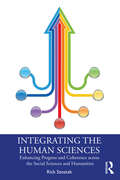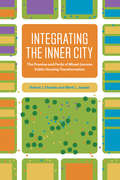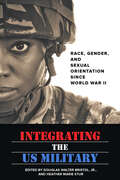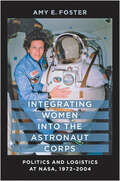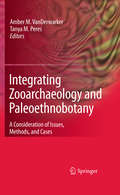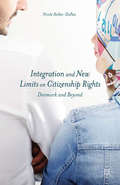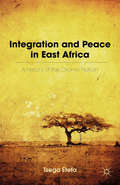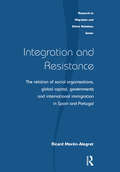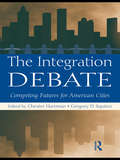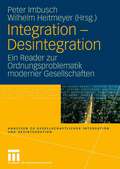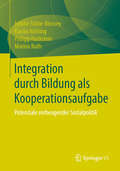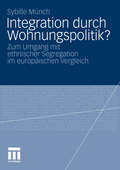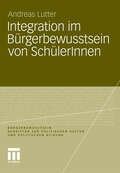- Table View
- List View
Integrating Sustainable Development in International Investment Law: Normative Incompatibility, System Integration and Governance Implications (ISSN)
by Manjiao ChiThe current international investment law system is insufficiently compatible with sustainable development. To better address sustainable development concerns associated with transnational investment activities, international investment agreements should be made more compatible with sustainable development.Integrating Sustainable Development in International Investment Lawpresents an important systematic study of the issue of sustainable development in the international investment law system, using conceptual, normative and governance perspectives to explore the challenges and possible solutions for making international investment law more compatible with sustainable development. Chi suggests that to effectively address the sustainable development concerns associated with transnational investment activities, the international investment agreements system should be reformed. Such reform should feature redesigning the provisions of the agreements, improving the structure of international investment agreements, strengthening the function of soft law, engaging non-state actors and enhancing the dispute settlement mechanism.The book is primarily aimed at national and international treaty and policy-makers, lawyers and scholars. It is also suitable for graduate students studying international law and policy-making.The Open Access version of this book, available at http://www.taylorfrancis.com, has been made available under a Creative Commons Attribution-Non Commercial-No Derivatives (CC-BY) 4.0 license.
Integrating the Human Sciences: Enhancing Progress and Coherence across the Social Sciences and Humanities
by Rick SzostakWhat if we recognized that the human sciences collectively investigate a few dozen key phenomena that interact with each other? Can we imagine a human science that would seek to stitch its understandings of this system of phenomena into a coherent whole? If so, what would that look like? This book argues that we are unlikely to develop one unified "theory of everything." Our collective understanding must then be a "map" of the myriad relationships within this large – but finite and manageable – system, coupled with detailed understandings of each causal link and of important subsystems. The book outlines such a map and shows that the pursuit of coherence – and a more successful human science enterprise – requires integration, recognizing the strengths and weaknesses of different methods and theory types, and the pursuit of terminological and presentational clarity. It explores how these inter-connected goals can be achieved in research, teaching, library classification, public policy, and university administration. These suggestions are congruent with, and yet enhance, other projects for reform of the human sciences. This volume is aimed at any scholar or student who seeks to comprehend how what they study fits within a broader understanding.
Integrating the Human Sciences: Enhancing Progress and Coherence across the Social Sciences and Humanities
by Rick SzostakWhat if we recognized that the human sciences collectively investigate a few dozen key phenomena that interact with each other? Can we imagine a human science that would seek to stitch its understandings of this system of phenomena into a coherent whole? If so, what would that look like? This book argues that we are unlikely to develop one unified "theory of everything." Our collective understanding must then be a "map" of the myriad relationships within this large – but finite and manageable – system, coupled with detailed understandings of each causal link and of important subsystems. The book outlines such a map and shows that the pursuit of coherence – and a more successful human science enterprise – requires integration, recognizing the strengths and weaknesses of different methods and theory types, and the pursuit of terminological and presentational clarity. It explores how these inter-connected goals can be achieved in research, teaching, library classification, public policy, and university administration. These suggestions are congruent with, and yet enhance, other projects for reform of the human sciences. This volume is aimed at any scholar or student who seeks to comprehend how what they study fits within a broader understanding.
Integrating the Inner City: The Promise and Perils of Mixed-Income Public Housing Transformation
by Robert J. Chaskin Mark L. JosephFor many years Chicago’s looming large-scale housing projects defined the city, and their demolition and redevelopment—via the Chicago Housing Authority’s Plan for Transformation—has been perhaps the most startling change in the city’s urban landscape in the last twenty years. The Plan, which reflects a broader policy effort to remake public housing in cities across the country, seeks to deconcentrate poverty by transforming high-poverty public housing complexes into mixed-income developments and thereby integrating once-isolated public housing residents into the social and economic fabric of the city. But is the Plan an ambitious example of urban regeneration or a not-so-veiled effort at gentrification? In the most thorough examination of mixed-income public housing redevelopment to date, Robert J. Chaskin and Mark L. Joseph draw on five years of field research, in-depth interviews, and volumes of data to demonstrate that while considerable progress has been made in transforming the complexes physically, the integrationist goals of the policy have not been met. They provide a highly textured investigation into what it takes to design, finance, build, and populate a mixed-income development, and they illuminate the many challenges and limitations of the policy as a solution to urban poverty. Timely and relevant, Chaskin and Joseph’s findings raise concerns about the increased privatization of housing for the poor while providing a wide range of recommendations for a better way forward.
Integrating the Inner City: The Promise and Perils of Mixed-Income Public Housing Transformation
by Robert J. Chaskin Mark L. JosephFor many years Chicago’s looming large-scale housing projects defined the city, and their demolition and redevelopment—via the Chicago Housing Authority’s Plan for Transformation—has been perhaps the most startling change in the city’s urban landscape in the last twenty years. The Plan, which reflects a broader policy effort to remake public housing in cities across the country, seeks to deconcentrate poverty by transforming high-poverty public housing complexes into mixed-income developments and thereby integrating once-isolated public housing residents into the social and economic fabric of the city. But is the Plan an ambitious example of urban regeneration or a not-so-veiled effort at gentrification? In the most thorough examination of mixed-income public housing redevelopment to date, Robert J. Chaskin and Mark L. Joseph draw on five years of field research, in-depth interviews, and volumes of data to demonstrate that while considerable progress has been made in transforming the complexes physically, the integrationist goals of the policy have not been met. They provide a highly textured investigation into what it takes to design, finance, build, and populate a mixed-income development, and they illuminate the many challenges and limitations of the policy as a solution to urban poverty. Timely and relevant, Chaskin and Joseph’s findings raise concerns about the increased privatization of housing for the poor while providing a wide range of recommendations for a better way forward.
Integrating the Inner City: The Promise and Perils of Mixed-Income Public Housing Transformation
by Robert J. Chaskin Mark L. JosephFor many years Chicago’s looming large-scale housing projects defined the city, and their demolition and redevelopment—via the Chicago Housing Authority’s Plan for Transformation—has been perhaps the most startling change in the city’s urban landscape in the last twenty years. The Plan, which reflects a broader policy effort to remake public housing in cities across the country, seeks to deconcentrate poverty by transforming high-poverty public housing complexes into mixed-income developments and thereby integrating once-isolated public housing residents into the social and economic fabric of the city. But is the Plan an ambitious example of urban regeneration or a not-so-veiled effort at gentrification? In the most thorough examination of mixed-income public housing redevelopment to date, Robert J. Chaskin and Mark L. Joseph draw on five years of field research, in-depth interviews, and volumes of data to demonstrate that while considerable progress has been made in transforming the complexes physically, the integrationist goals of the policy have not been met. They provide a highly textured investigation into what it takes to design, finance, build, and populate a mixed-income development, and they illuminate the many challenges and limitations of the policy as a solution to urban poverty. Timely and relevant, Chaskin and Joseph’s findings raise concerns about the increased privatization of housing for the poor while providing a wide range of recommendations for a better way forward.
Integrating the Inner City: The Promise and Perils of Mixed-Income Public Housing Transformation
by Robert J. Chaskin Mark L. JosephFor many years Chicago’s looming large-scale housing projects defined the city, and their demolition and redevelopment—via the Chicago Housing Authority’s Plan for Transformation—has been perhaps the most startling change in the city’s urban landscape in the last twenty years. The Plan, which reflects a broader policy effort to remake public housing in cities across the country, seeks to deconcentrate poverty by transforming high-poverty public housing complexes into mixed-income developments and thereby integrating once-isolated public housing residents into the social and economic fabric of the city. But is the Plan an ambitious example of urban regeneration or a not-so-veiled effort at gentrification? In the most thorough examination of mixed-income public housing redevelopment to date, Robert J. Chaskin and Mark L. Joseph draw on five years of field research, in-depth interviews, and volumes of data to demonstrate that while considerable progress has been made in transforming the complexes physically, the integrationist goals of the policy have not been met. They provide a highly textured investigation into what it takes to design, finance, build, and populate a mixed-income development, and they illuminate the many challenges and limitations of the policy as a solution to urban poverty. Timely and relevant, Chaskin and Joseph’s findings raise concerns about the increased privatization of housing for the poor while providing a wide range of recommendations for a better way forward.
Integrating the Inner City: The Promise and Perils of Mixed-Income Public Housing Transformation
by Robert J. Chaskin Mark L. JosephFor many years Chicago’s looming large-scale housing projects defined the city, and their demolition and redevelopment—via the Chicago Housing Authority’s Plan for Transformation—has been perhaps the most startling change in the city’s urban landscape in the last twenty years. The Plan, which reflects a broader policy effort to remake public housing in cities across the country, seeks to deconcentrate poverty by transforming high-poverty public housing complexes into mixed-income developments and thereby integrating once-isolated public housing residents into the social and economic fabric of the city. But is the Plan an ambitious example of urban regeneration or a not-so-veiled effort at gentrification? In the most thorough examination of mixed-income public housing redevelopment to date, Robert J. Chaskin and Mark L. Joseph draw on five years of field research, in-depth interviews, and volumes of data to demonstrate that while considerable progress has been made in transforming the complexes physically, the integrationist goals of the policy have not been met. They provide a highly textured investigation into what it takes to design, finance, build, and populate a mixed-income development, and they illuminate the many challenges and limitations of the policy as a solution to urban poverty. Timely and relevant, Chaskin and Joseph’s findings raise concerns about the increased privatization of housing for the poor while providing a wide range of recommendations for a better way forward.
Integrating the Inner City: The Promise and Perils of Mixed-Income Public Housing Transformation
by Robert J. Chaskin Mark L. JosephFor many years Chicago’s looming large-scale housing projects defined the city, and their demolition and redevelopment—via the Chicago Housing Authority’s Plan for Transformation—has been perhaps the most startling change in the city’s urban landscape in the last twenty years. The Plan, which reflects a broader policy effort to remake public housing in cities across the country, seeks to deconcentrate poverty by transforming high-poverty public housing complexes into mixed-income developments and thereby integrating once-isolated public housing residents into the social and economic fabric of the city. But is the Plan an ambitious example of urban regeneration or a not-so-veiled effort at gentrification? In the most thorough examination of mixed-income public housing redevelopment to date, Robert J. Chaskin and Mark L. Joseph draw on five years of field research, in-depth interviews, and volumes of data to demonstrate that while considerable progress has been made in transforming the complexes physically, the integrationist goals of the policy have not been met. They provide a highly textured investigation into what it takes to design, finance, build, and populate a mixed-income development, and they illuminate the many challenges and limitations of the policy as a solution to urban poverty. Timely and relevant, Chaskin and Joseph’s findings raise concerns about the increased privatization of housing for the poor while providing a wide range of recommendations for a better way forward.
Integrating the US Military: Race, Gender, and Sexual Orientation since World War II
by Douglas W. Bristol Jr. Heather Marie SturOne of the great ironies of American history since World War II is that the military;¢;‚¬;€?typically a conservative institution;¢;‚¬;€?has often been at the forefront of civil rights. In the 1940s, the 1970s, and the early 2000s, military integration and promotion policies were in many ways more progressive than similar efforts in the civilian world. Today, the military is one of the best ways for people from marginalized groups to succeed based solely on job performance.Integrating the US Military traces the experiences of African Americans, Japanese Americans, women, and gay men and lesbians in the armed forces since World War II. By examining controversies from racial integration to the dismantling of "Don;€™t Ask, Don;€™t Tell" to the recent repeal of the ban on women in combat, these essays show that the military is an important institution in which social change is confirmed and, occasionally, accelerated. Remarkably, the challenges launched against the racial, gender, and sexual status quo in the postwar years have also broadly transformed overarching ideas about power, citizenship, and America;€™s role in the world.The first comparative study of legally marginalized groups within the armed services, Integrating the US Military is a unique look at the history of military integration in theory and in practice. The book underscores the complicated struggle that accompanied integration and sheds new light on a broad range of comparable issues that affect civilian society, including affirmative action, marriage laws, and sexual harassment.
Integrating the US Military: Race, Gender, and Sexual Orientation since World War II
by Douglas W. Bristol Jr. Heather Marie SturOne of the great ironies of American history since World War II is that the military;¢;‚¬;€?typically a conservative institution;¢;‚¬;€?has often been at the forefront of civil rights. In the 1940s, the 1970s, and the early 2000s, military integration and promotion policies were in many ways more progressive than similar efforts in the civilian world. Today, the military is one of the best ways for people from marginalized groups to succeed based solely on job performance.Integrating the US Military traces the experiences of African Americans, Japanese Americans, women, and gay men and lesbians in the armed forces since World War II. By examining controversies from racial integration to the dismantling of "Don;€™t Ask, Don;€™t Tell" to the recent repeal of the ban on women in combat, these essays show that the military is an important institution in which social change is confirmed and, occasionally, accelerated. Remarkably, the challenges launched against the racial, gender, and sexual status quo in the postwar years have also broadly transformed overarching ideas about power, citizenship, and America;€™s role in the world.The first comparative study of legally marginalized groups within the armed services, Integrating the US Military is a unique look at the history of military integration in theory and in practice. The book underscores the complicated struggle that accompanied integration and sheds new light on a broad range of comparable issues that affect civilian society, including affirmative action, marriage laws, and sexual harassment.
Integrating Theory and Practice in Social Work Education (PDF)
by Chris Player Florence Watson Helen BurrowsThis clear and instructive text gives practical advice on how to write better essays or assessments and give better presentations within social work. It shows how practitioners and students can apply theoretical considerations to practical social work and how they can articulate this connection in written or oral reports, both in pre-qualification and for professional development post-qualification. The authors, experienced teachers and researchers in social work education, explain how to go about gathering evidence from fieldwork and practice placements and how to prepare and plan an assignment or project. They give guidance on incorporating ethical considerations and theoretical developments, applying law and policy, and developing all these aspects in reflection, analysis and evaluation of practice. Also included are helpful sections on vivas in borderline situations and how to react in the case of failure. This clear and accessible guide will be invaluable to social work students, practice teachers, social work practitioners and social service managers.
Integrating Women into the Astronaut Corps: Politics and Logistics at NASA, 1972–2004
by Amy E. FosterWhy, Amy E. Foster asks, did it take two decades after the Soviet Union launched its first female cosmonaut for the United States to send its first female astronaut into space? In answering this question, Foster recounts the complicated history of integrating women into NASA’s astronaut corps. NASA selected its first six female astronauts in 1978. Foster examines the political, technological, and cultural challenges that the agency had to overcome to usher in this new era in spaceflight. She shows how NASA had long developed progressive hiring policies but was limited in executing them by a national agenda to beat the Soviets to the moon, budget constraints, and cultural ideas about women’s roles in America. Lively writing and compelling stories, including personal interviews with America’s first women astronauts, propel Foster’s account. Through extensive archival research, Foster also examines NASA’s directives about sexual discrimination, the technological issues in integrating women into the corps, and the popular media’s discussion of women in space. Foster puts together a truly original study of the experiences not only of early women astronauts but also of the managers and engineers who helped launch them into space.In documenting these events, Foster offers a broader understanding of the difficulties in sexually integrating any workplace, even when the organization approaches the situation with as positive an outlook and as strong a motivation as did NASA.
Integrating Women into the Astronaut Corps: Politics and Logistics at NASA, 1972–2004
by Amy E. FosterWhy, Amy E. Foster asks, did it take two decades after the Soviet Union launched its first female cosmonaut for the United States to send its first female astronaut into space? In answering this question, Foster recounts the complicated history of integrating women into NASA’s astronaut corps. NASA selected its first six female astronauts in 1978. Foster examines the political, technological, and cultural challenges that the agency had to overcome to usher in this new era in spaceflight. She shows how NASA had long developed progressive hiring policies but was limited in executing them by a national agenda to beat the Soviets to the moon, budget constraints, and cultural ideas about women’s roles in America. Lively writing and compelling stories, including personal interviews with America’s first women astronauts, propel Foster’s account. Through extensive archival research, Foster also examines NASA’s directives about sexual discrimination, the technological issues in integrating women into the corps, and the popular media’s discussion of women in space. Foster puts together a truly original study of the experiences not only of early women astronauts but also of the managers and engineers who helped launch them into space.In documenting these events, Foster offers a broader understanding of the difficulties in sexually integrating any workplace, even when the organization approaches the situation with as positive an outlook and as strong a motivation as did NASA.
Integrating Zooarchaeology and Paleoethnobotany: A Consideration of Issues, Methods, and Cases
by Amber M. VanDerwarker Tanya M. PeresIn recent years, scholars have emphasized the need for more holistic subsistence analyses, and collaborative publications towards this endeavor have become more numerous in the literature. However, there are relatively few attempts to qualitatively integrate zooarchaeological (animal) and paleoethnobotanical (plant) data, and even fewer attempts to quantitatively integrate these two types of subsistence evidence. Given the vastly different methods used in recovering and quantifying these data, not to mention their different preservational histories, it is no wonder that so few have undertaken this problem. Integrating Zooarchaeology and Paleoethnobotany takes the lead in tackling this important issue by addressing the methodological limitations of data integration, proposing new methods and innovative ways of using established methods, and highlighting case studies that successfully employ these methods to shed new light on ancient foodways. The volume challenges the perception that plant and animal foodways are distinct and contends that the separation of the analysis of archaeological plant and animal remains sets up a false dichotomy between these portions of the diet. In advocating qualitative and quantitative data integration, the volume establishes a clear set of methods for (1) determining the suitability of data integration in any particular case, and (2) carrying out an integrated qualitative or quantitative approach.
Integration and New Limits on Citizenship Rights: Denmark and Beyond
by N. Stokes-DuPassIntegration and New Limits on Citizenship Rights is a state-centered analysis of citizenship, immigration and social identity. It explores the increasing role of nation states as critical actors in using social policy to affect the social location of immigrants and ethnics and also to redefine what it means to be a full citizen.
Integration and Peace in East Africa: A History of the Oromo Nation
by T. EtefaThis book analyzes the development of indigenous religious, commercial, and political institutions among the Oromo mainly during the relatively peaceful two centuries in its history, from 1704 to 1882. The largest ethnic group in East Africa, the Oromo promoted peace, cultural assimilation, and ethnic integration.
Integration and Resistance: The Relation of Social Organisations, Global Capital, Governments and International Immigration in Spain and Portugal (Research in Migration and Ethnic Relations Series)
by Ricard Moren-AlegretIntegration is a key challenge facing modern society today. Integration and Resistance offers a new theoretical perspective for considering integration. By focusing on international immigrants and their organisations from a wider perspective the author demonstrates that the threat to social integration does not lie with the immigrants themselves but with global capital and the state. By analysis of data collected in Spain and Portugal the book breaks new ground in providing information on processes occurring in intermediate-capitalist countries that share some aspects of economic development, social and migration features with Northern Europe and America whilst also sharing other features such as the economic dependence of more impoverished countries.
Integration and Resistance: The Relation of Social Organisations, Global Capital, Governments and International Immigration in Spain and Portugal (Research in Migration and Ethnic Relations Series)
by Ricard Moren-AlegretIntegration is a key challenge facing modern society today. Integration and Resistance offers a new theoretical perspective for considering integration. By focusing on international immigrants and their organisations from a wider perspective the author demonstrates that the threat to social integration does not lie with the immigrants themselves but with global capital and the state. By analysis of data collected in Spain and Portugal the book breaks new ground in providing information on processes occurring in intermediate-capitalist countries that share some aspects of economic development, social and migration features with Northern Europe and America whilst also sharing other features such as the economic dependence of more impoverished countries.
The Integration Debate: Competing Futures For American Cities
by Chester Hartman Gregory SquiresRacial integration, and policies intended to achieve greater integration, continue to generate controversy in the United States, with some of the most heated debates taking place among long-standing advocates of racial equality. Today, many nonwhites express what has been referred to as "integration exhaustion" as they question the value of integration in today’s world. And many whites exhibit what has been labeled "race fatigue," arguing that we have done enough to reconcile the races. Many policies have been implemented in efforts to open up traditionally restricted neighborhoods, while others have been designed to diversify traditionally poor, often nonwhite, neighborhoods. Still, racial segregation persists, along with the many social costs of such patterns of uneven development. This book explores both long-standing and emerging controversies over the nation’s ongoing struggles with discrimination and segregation. More urgently, it offers guidance on how these barriers can be overcome to achieve truly balanced and integrated living patterns.
The Integration Debate: Competing Futures For American Cities
by Chester Hartman Gregory D. SquiresRacial integration, and policies intended to achieve greater integration, continue to generate controversy in the United States, with some of the most heated debates taking place among long-standing advocates of racial equality. Today, many nonwhites express what has been referred to as "integration exhaustion" as they question the value of integration in today’s world. And many whites exhibit what has been labeled "race fatigue," arguing that we have done enough to reconcile the races. Many policies have been implemented in efforts to open up traditionally restricted neighborhoods, while others have been designed to diversify traditionally poor, often nonwhite, neighborhoods. Still, racial segregation persists, along with the many social costs of such patterns of uneven development. This book explores both long-standing and emerging controversies over the nation’s ongoing struggles with discrimination and segregation. More urgently, it offers guidance on how these barriers can be overcome to achieve truly balanced and integrated living patterns.
Integration - Desintegration: Ein Reader zur Ordnungsproblematik moderner Gesellschaften (Analysen zu gesellschaftlicher Integration und Desintegration)
Integration durch Bildung als Kooperationsaufgabe: Potenziale vorbeugender Sozialpolitik
by Sybille Stöbe-Blossey Karola Köhling Philipp Hackstein Marina RuthDas Buch enthält die Beschreibung und Ergebnisse der Studie „Kooperation von Akteuren vorbeugender Sozialpolitik. Eine Analyse am Beispiel der Berufsorientierung jugendlicher Flüchtlinge“. Auf der Basis eines theoretischen Rahmens zur Analyse von förderlichen und hemmenden Faktoren für Kooperation wurden qualitative Interviews mit lokalen Akteuren – Koordinierungsstellen, beruflichen Schulen, Jugendhilfe, Arbeitsverwaltung – geführt und ausgewertet. Der Band stellt Rahmenbedingungen, Probleme und Chancen für die Kooperation auf lokaler Ebene dar, gibt einen Einblick in die Praxis der Förderung von Integration durch Bildung und diskutiert Möglichkeiten für die (Weiter-)Entwicklung von Kooperation.Der Inhalt• Politikfeldübergreifende Kooperation in der vorbeugenden Sozialpolitik: Grundlagen • Kooperationen auf lokaler Ebene: Empirische Analysen am Beispiel der Berufsorientierung für jugendliche FlüchtlingeDie Autor_innenProfessor Dr. Sybille Stöbe-Blossey ist Abteilungsleiterin am Institut Arbeit und Qualifikation, Abteilung Bildung und Erziehung im Strukturwandel (BEST), der Universität Duisburg-Essen. Dr. Karola Köhling, Philipp Hackstein und Marina Ruth sind wissenschaftliche Mitarbeiter_innen am Institut Arbeit und Qualifikation, Abteilung Bildung und Erziehung im Strukturwandel (BEST), der Universität Duisburg-Essen.

